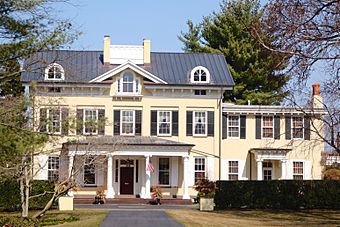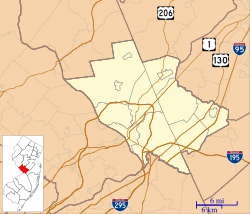Westland Mansion facts for kids
|
Grover Cleveland Home
|
|
|
U.S. Historic district
Contributing property |
|

Westland, home of Grover Cleveland, shown in 2009
|
|
| Location | 15 Hodge Road, Princeton, New Jersey |
|---|---|
| Built | mid-1800s |
| Part of | Princeton Historic District (ID75001143) |
| NRHP reference No. | 66000463 |
Quick facts for kids Significant dates |
|
| Added to NRHP | October 15, 1966 |
| Designated NHL | June 23, 1965 |
Westland Mansion was the home of Grover Cleveland. He was the 22nd and 24th President of the United States. He lived there from 1897 until he passed away in 1908. The house is in the historic district of Princeton, New Jersey. It is a National Historic Landmark and is also known as the Grover Cleveland Home.
The Story of Westland
How Westland Was Built
The Westland house was built in 1856 by Robert F. Stockton. The original house was a large stone building with two and a half stories. It had yellow walls and was designed like another famous house nearby called Morven. Inside, it had big rooms with tall ceilings and beautiful marble fireplaces.
Robert Stockton came from a very important political family. He was a United States Senator and a naval commodore. He was known for helping to capture California during a war. His grandfather, Judge Richard Stockton, was famous for signing the Declaration of Independence.
The original property was about 4.5 acres. It had large lawns and fruit trees. Later, a small part was added to the back of the house. This part was for servants and horses. Now, this added part is a separate home. The house used to be entered from a stone road. There were nice paths on the lawn, shaded by big pine trees. Behind the house, there was an orchard with pear and cherry trees. There was also a small house for pigeons and doves.
President Cleveland's Home
Grover Cleveland bought Westland after his second term as president in 1896. He lived there from 1897 until he died in 1908. Cleveland named the house "Westland" to honor his friend, Andrew Fleming West. Andrew West was a professor at Princeton University. He helped Cleveland buy the house.
While Cleveland lived at Westland, he made some changes. He added a two-story section to the right side of the house. The bottom floor of this new section was his billiard room. Cleveland also updated the outside of the house. He used the Italianate style, which was popular at the time.
Cleveland really enjoyed his time at Westland. Even though he never went to college, he joined the Board of Trustees at Princeton University. He took this job seriously. He even led a group that helped start a graduate school there. He also gave four popular talks at the university. These talks were later published as a book.
The students at Princeton liked Cleveland a lot. They would sing to him on his birthdays. After football games, they would march to his house to celebrate victories. Cleveland was also active in the town. He wrote many letters to friends. He stayed involved in social and political life. His favorite hobbies were playing billiards and meeting with his "Poverty Club." This was a group of friends who played cards regularly at Westland.
Grover Cleveland passed away at Westland in 1908. He is buried in Princeton Cemetery. His wife, Frances, continued to live in the house for many years after he died.
Westland Today
Westland Mansion has always been a private home. Today, the renovated house sits on about one and a half acres. It is a three-level house with 6,345 square feet of space. It has 6 bedrooms and 5 bathrooms. The main entrance, dining room, and living rooms still have original details from Cleveland's time. The property also has a formal garden, a swimming pool, and a garage. In 2015, the house was sold for $4,325,000. It is not open for the public to visit.




